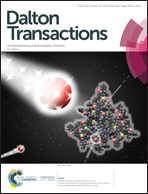Copper hydride-mediated electrophilic amidation of vinylarenes with dioxazolones – a computational mechanistic study†
Abstract
A detailed computational mechanistic study of the CuH-catalysed formal hydroamidation of vinylarenes with dioxazolone and hydrosilane by a prototype (dppbz)CuH catalyst (dppbz ≡ {P^P} ≡ 1,2-bis(diphenylphosphino)benzene) is presented. Probing various plausible pathways for relevant elementary steps with the aid of a reliable computational protocol applied to a realistic catalyst model identified the pathways preferably traversed in productive catalysis. It entails hydrocupration exclusively generating the benzylcopper nucleophile that undergoes amidation with the dioxazolone electrophile to afford copper amidate. Umpolung electrophilic amidation favours a stepwise oxidative Cu![[double bond, length as m-dash]](https://www.rsc.org/images/entities/char_e001.gif) N coupling with a simultaneous decarboxylation/C–N bond forming reductive elimination sequence. Copper amidate represents the catalyst resting state. Its conversion back into the catalytically active copper hydride upon transmetalation with hydrosilane involves fast nucleophilic attack followed by slow hydrogen atom transfer. Electron-poor styrenes accelerate the hydrocupration with a noticeably reduced barrier found for styrene featuring a para-CF3 substituted phenyl ring. On the other hand, transmetalation becomes faster the more electron-rich the oxazolone amidating agent is.
N coupling with a simultaneous decarboxylation/C–N bond forming reductive elimination sequence. Copper amidate represents the catalyst resting state. Its conversion back into the catalytically active copper hydride upon transmetalation with hydrosilane involves fast nucleophilic attack followed by slow hydrogen atom transfer. Electron-poor styrenes accelerate the hydrocupration with a noticeably reduced barrier found for styrene featuring a para-CF3 substituted phenyl ring. On the other hand, transmetalation becomes faster the more electron-rich the oxazolone amidating agent is.



 Please wait while we load your content...
Please wait while we load your content...